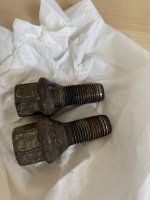Hello there,
I've got a 68 plate pop with 42k on the clock. Yesterday I wanted to check the front brake pads and discs. When I came to remove the front wheels I found several wheel bolts difficult to remove. Bearing in mind the wheels had already been removed in January.
Anyway to cut a long story short one thread on each side has stripped (not badly) but enough to have me annoyed! I’ve never had this issue before on any car, even the previous generation panda that I’ve owned for 12 years now. I always use a torque wrench to tighten my wheel bolts to 85NM.
My thoughts are the metal that the hub flange is made from is like cheese. In addition, water and salt has got behind the hub assembly and almost corroded the bolts in place
I was thinking possibly to peruse Fiat for a warranty claim but I doubt I’ll get far. Having looked on Eper for the part numbers, the hub flange is different to the older panda/500 so you can only get them from a dealer at £150 quid each!!! So if the wheel bearings also need to be replaced at the same time the job could easily be £500+. A very poor outcome for such a new car.
I had a brain wave this morning why not helicoil the damaged threads? I’ve seen it’s possible to do, and I have used them before for various applications.
I’ve already got an M12x1.25 kit but having measured up the hub flange and how far the wheel bolts actually go in I’ll need 1D (12mm).
What are people’s thoughts doing on this?
I have to say this car hasn’t been totally trouble free throughout its life and this seems to me another example of cheaply manufactured parts. How would I stop this happening again in future?
Adam
I've got a 68 plate pop with 42k on the clock. Yesterday I wanted to check the front brake pads and discs. When I came to remove the front wheels I found several wheel bolts difficult to remove. Bearing in mind the wheels had already been removed in January.
Anyway to cut a long story short one thread on each side has stripped (not badly) but enough to have me annoyed! I’ve never had this issue before on any car, even the previous generation panda that I’ve owned for 12 years now. I always use a torque wrench to tighten my wheel bolts to 85NM.
My thoughts are the metal that the hub flange is made from is like cheese. In addition, water and salt has got behind the hub assembly and almost corroded the bolts in place
I was thinking possibly to peruse Fiat for a warranty claim but I doubt I’ll get far. Having looked on Eper for the part numbers, the hub flange is different to the older panda/500 so you can only get them from a dealer at £150 quid each!!! So if the wheel bearings also need to be replaced at the same time the job could easily be £500+. A very poor outcome for such a new car.
I had a brain wave this morning why not helicoil the damaged threads? I’ve seen it’s possible to do, and I have used them before for various applications.
I’ve already got an M12x1.25 kit but having measured up the hub flange and how far the wheel bolts actually go in I’ll need 1D (12mm).
What are people’s thoughts doing on this?
I have to say this car hasn’t been totally trouble free throughout its life and this seems to me another example of cheaply manufactured parts. How would I stop this happening again in future?
Adam


